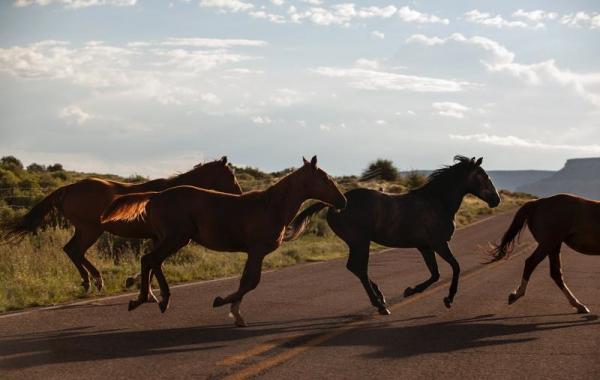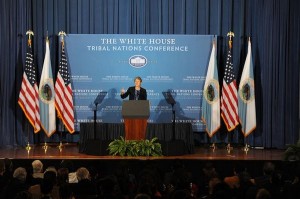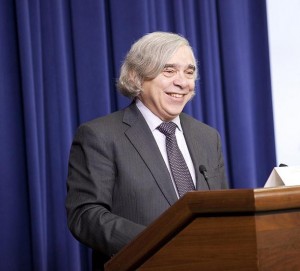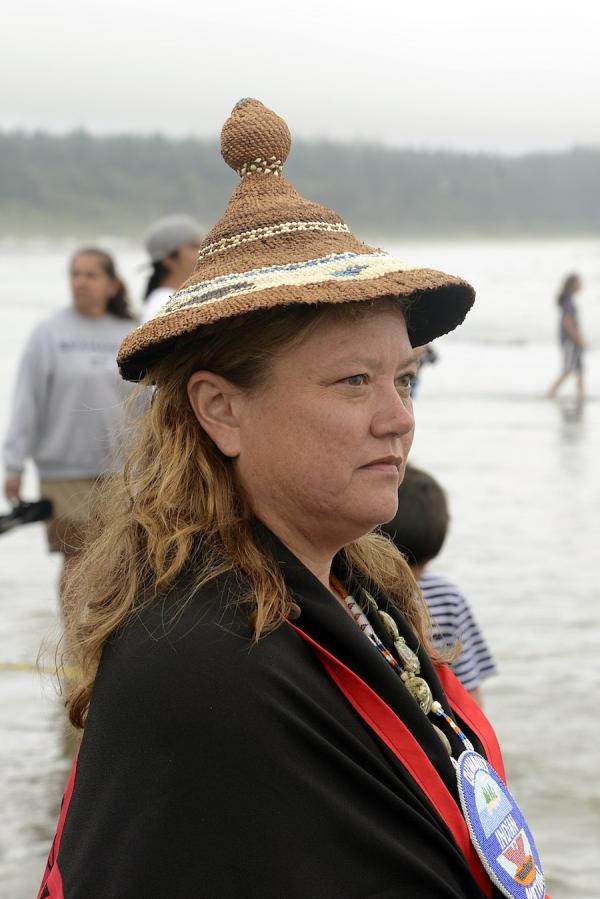 Kevin Taylor, Indian Country Today Media Network
Kevin Taylor, Indian Country Today Media Network
You can lead a horse to a slaughter … or can you?
In the United States, the answer is, Not yet.
An federal appellate court in Denver late Monday issued an emergency injunction on behalf of the Humane Society of the United States and other groups opposed to the practice of killing horses for food. The injunction blocks another federal judge’s ruling from Friday that cleared the way for three meatpacking plants to resume horse slaughter for the first time in six years — a move that was both supported and opposed by Native Americans.
“Horse slaughter is a predatory, inhumane business, and we are pleased to win another round in the courts to block killing of these animals on American soil for export to Italy and Japan,” said Wayne Pacelle, president and CEO of The Humane Society of the United States in a statement. “Meanwhile, we are redoubling our efforts in Congress to secure a permanent ban on the slaughter of our horses throughout North America.”
It seems unusual to say “win another round” when Judge Christina Armijo of the U.S. District Court in New Mexico on Friday dismissed a lawsuit brought last summer by Pacelle’s HSUS, Front Range Equine Rescue and about a dozen more animal welfare groups and several individual Native Americans.
The suit argued that the permits issued to the packing plants required environmental review under the National Environmental Policy Act. Armijo ruled that NEPA did not apply when an agency’s action, in this case USDA health inspection, was mandatory. She also noted in her ruling that the Tenth Circuit Court of Appeals, which granted the emergency injunction Monday, had reached the same conclusion about NEPA in a different case.
Even as he vowed to join the appeal, make “a full rush with Congress” and lobby states to prohibit horse slaughter, former New Mexico Gov. Bill Richardson told USA Today over the weekend, “The odds are not that good about stopping this, but it’s not over.”
The injunction prevents horse slaughter until the appeal is heard.
One plant, in Roswell, N.M., has stock waiting in Texas feedlots and was ready to open next week. “After talking to the USDA today (Monday, Nov. 4), they said they could have inspectors available by the 11th,” said Rick De Los Santos, owner of Valley Meat.
Rick De Los Santos, owner of Valley Meat (AP)
GROWING ISSUE IN THE WEST
Slaughter affects about 2 percent of the estimated 7 million horses in the United States annually. This is a rough estimate as there has not been a census of horses since 2004, according to Nat Messer, DVM, professor of equine medicine and surgery at University of Missouri. The stereotype that has broke-down racehorses or work horses shipped off to a meat-packing plant or glue factory at the end of their days is outmoded. The racing industry and breed associations have reacted to bad publicity by striving to better control the number of horses bred each year, Messer said. There has also been a rise in retirement farms or therapeutic riding programs as a slaughter alternative for older horses. Unregistered horses, whether they be work horses or riding horses, appear to comprise the majority of horses sent to packing plants.
And slaughter has not stopped since Congress essentially banned it in 2006 by stripping funding for USDA inspectors. It has moved across the borders to Canada and Mexico, where between 140,000 and 160,000 U.S. horses have been shipped every year since the domestic slaughter plants closed, according to information from Stephen MacDonald, Agricultural Economist with the office of USDA Economic Research.
But across the arid and semi-arid West — much of Indian Country, in other words — the question of what to do with too many wild, feral or unwanted horses is still a thorny one where there is far less control over equine population and where the big, charismatic animals find themselves in a complex emotional, historical and cultural landscape.
“One of the dilemmas we have is that the horse plays a very important, traditionally intricate role in our society. If it wasn’t for the horse, we probably wouldn’t be the people that we are,” said Harry Smiskin, chairman of the Yakama Nation in Washington state.
The Yakama, early adopters of the horse among Plateau Culture tribes, is among several tribes that came out this year in support of reopening equine slaughter plants. The tribe estimates the number of wild or feral horses on the reservation has grown to 12,000 since the Congressional ban.
“The dilemma we are facing is that these wild horses, or feral horses, are causing severe degradation to the natural resources of our land. As American Indian people, the native people of the land, we utilize a lot of the plants, the herbs and roots from Mother Earth. When you walk onto the landscape of Yakama Nation rangeland, it becomes a moonscape because the horses come through there and what they don’t eat off, they trample down to bare dirt,” Smiskin said. In central Washington’s semi-arid shrub-steppe habitat, the landscape “is definitely fragile. We have spent a lot of time, effort and money trying to manage this fragile ecosystem that we have to keep it in balance, and with the horse right now it is completely out of balance.”
Another tribal leader, President Ben Shelly of the Navajo Nation, also came out in support of the reopening of horse slaughter plants in late summer. His reasoning echoed Smiskin’s.
“The horse is a sacred animal to our people. They have their own songs, they have their own prayers,” he told Indian Country Today in August. “We also believe we need to balance our life, balance our resources. Right now it’s out of balance — there’s too many horses. We can only hold 30,000 and now we’re in the 75,000-plus.”
Shelly, too, described degradation of natural resources and stress on water in drought years. He testified before the Bureau of Land Management’s National Wild Horse and Burro Advisory Board in Arlington, Va., in September that the growing feral horse population was a financial burden on the tribe (more than $200,000 a year in damage control) and that the federal agencies were not living up to trust responsibilities to help the tribe manage its natural resources.
Wranglers cornered and captured five free-roaming horses in Manuelito, New Mexico. In Navajo territory, parched by years of drought and beset by poverty, one feral horse consumes 5 gallons of water and 18 pounds of forage a day. (Diego James Robles)
NAVAJO LEADER’S REVERSAL
Shelly in August authorized roundups of feral horses, even appropriating copy.4 million to the tribal Department of Agriculture for the task. Various communities on the sprawling reservation held roundups that gathered 1,600 horses. The tribe sells to individuals, not packing plants, but it is widely assumed that buyers had most of those horses trucked over the border to meet their fate in a Mexican slaughterhouse.
Many Navajo were outraged by Shelley’s stand. “This is a Shameful Time in Indian Country! And because of your Support of “Valley Meat Company” Horse Slaughtering Plant, I have Lost ALL my Respect for the NCAI & for the Leadership of the Navajo Nation.,” one Navajo tribal member wrote in a Facebook post.
The NCAI, National Congress of American Indians, passed a resolution in late summer supporting domestic horse slaughter and calling for a line item in the Bureau of Indian Affairs budget specific to management of overpopulation of feral horses on reservations.
Shelly was battered by criticism from traditionalists and elders.
“The healing people,” said Leland Grass of Diné for Wild Horses. “We are going to fight this to the very end.”
Grass spoke to Indian Country Today recently by cell phone atop his horse, Blondie, a captured mustang, during a three-day ride to Tuba City with other Nohooka’ Diné — Elders and Medicine People of the Diné — to perform a healing ceremony for horses.
After Shelly came out in support of horse slaughter, Grass and other healers denounced the decision in a resolution that called for Shelly to “stop the desecration and destruction of the Dine’ Way of Life and Spiritual Foundation by recklessly promoting and supporting the round-up and mass execution of our spiritual relative the Horse.”
The roundups were controversial as tribal members reported horses injured or exhausted as they were hazed by ATVs and dirt bikes.
Opposition mounted throughout the fall, during election season. Then, a month ago, Shelly did an abrupt about-face, announcing a Memorandum of Understanding to oppose slaughterhouses that he agreed to with former governor Richardson. Richardson last summer co-created The Foundation To Protect New Mexico Wildlife with actor and environmentalist Robert Redford specifically to oppose horse slaughter.
Richardson met Shelly at the Northern Navajo Fair in Shiprock in early October. They spent the weekend hashing out the horse issue in nearby Farmington, just off the reservation, and announced a proposed MOU that would reject slaughter and instead focus on adoption and birth control among tools to control horse population.
The MOU was expected well before the end of October but, as of Monday, Nov. 4, “is still being negotiated,” said Navajo spokesman Erny Zah.
According to some ranchers, to control the overpopulation of feral horses, there are two options: slaughter, or their own slow death by thirst or disease. (Diego James Robles)
‘FORCED TO BOARD HORSES’
“We were not happy to hear about that,” Smiskin of the Yakama said about Shelly’s reversal.
The Yakama and two nearby Oregon tribes, the Confederated Tribes of Warm Springs Reservation and the Confederated Tribes of the Umatilla Reservation, have tried slaughter alternatives such as those proposed in the MOU: roundups for adoption and castration of stallions, they considered birth control for mares, all of which they say are costly in time and dollars for little return.
Gordy Schumacher, Natural Resources program manager for the Umatilla, said the reservation in northeastern Oregon has seen increasing numbers of horses simply dumped by owners who could no longer afford them in the recession, and as the price of hay has tripled in recent years.
The tribe launched a roundup for adoption last year. Only 17 horses were captured. Two injured horses were given to a sanctuary, most of the rest were auctioned but interest was so slim that the last six were simply given away to new owners. “Five of those wound up back on the reservation,” Schumacher said.
Eddie Gunnier, a Yakama tribal member, has done horse trapping, said when the domestic slaughterhouses closed in 2007 the greater shipping distances to Mexico or Canada forced buyers to slash prices. The reduced price versus high costs of gasoline essentially ended horse trapping save for tribal population-control experiments. The castration of stallions was an experiment that ended quickly, he said.
Gunnier and Smiskin said the Yakama considered injections of a birth control drug for wild mares, but balked at the cost as mares would have to be repeatedly rounded up and injected as the drug wore off.
Smiskin said even a slaughterhouse in New Mexico may not be economically feasible. He said area tribes may revive a discussion to site a packing plant closer to the interior Northwest. A proposal for such a plant in Hermiston, Ore., was withdrawn last year after much opposition.
Such opposition to slaughter leaves tribes holding the bag, said John Boyd, a New Mexico attorney who represented the Yakama Nation in the federal lawsuit. “People who don’t want to see any horse slaughtered for any reason — you have Robert Redford and Bill Richardson and anti-animal cruelty organizations — saying you must not slaughter the horses, you must not do this. … In essence, tribes will be forced to support loss of environment, loss of native plants and board a huge population of horses for the emotional benefit of well-meaning horse lovers who are not prepared to fund any sort of solution.”
Smiskin added, “The horse is very important to our culture and traditions. We always want to have a number of those. However, the wild horse was degrading our range areas where a lot of our Indian foods and our medicinal plants grow. You weigh the priority, and right now we think Indian food — those roots that grow in the ground wild up there — are just as important as the wild horses.
“We don’t intend to eliminate our wild herd. We intend to bring it down to a manageable level.”
This April 15, 2013, file photo shows Valley Meat Co., which has been sitting idle for more than a year, waiting for the Department of Agriculture to approve its plans to slaughter horses. A federal appeals court on Monday, November 4, 2013, temporarily halted plans by companies in two U.S. states to begin slaughtering horses, continuing on-again, off-again efforts to resume domestic equine slaughter two years after Congress lifted a ban on the practice. (AP Photo/Jeri Clausing, File)


















